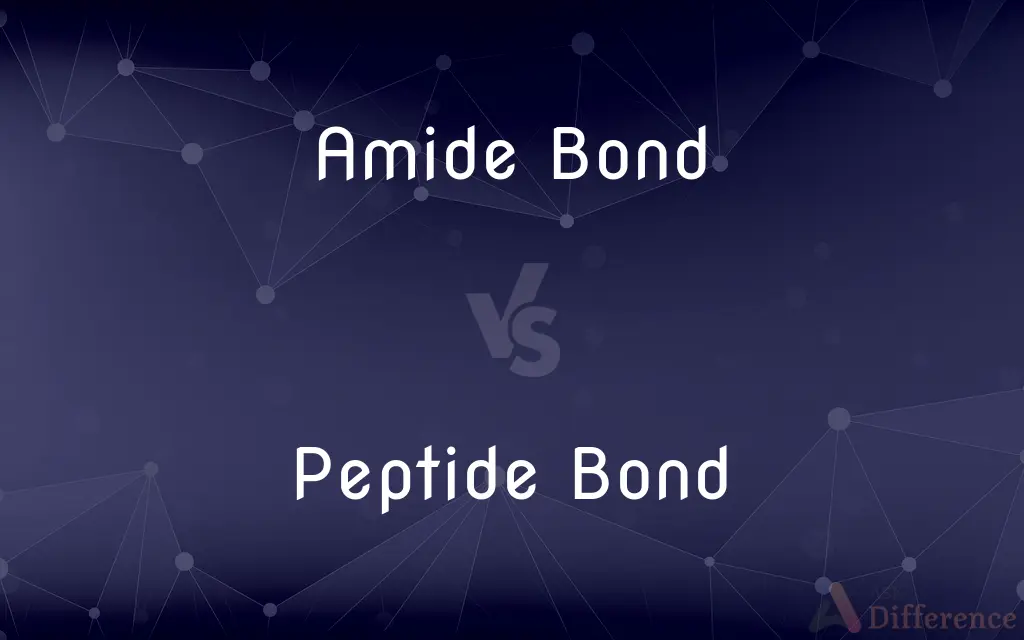Amide Bond vs. Peptide Bond — What's the Difference?
Edited by Tayyaba Rehman — By Fiza Rafique — Published on December 16, 2023
Amide Bond is a linkage between a carbonyl carbon and a nitrogen atom. Peptide Bond is a specific amide bond between amino acids in proteins.

Difference Between Amide Bond and Peptide Bond
Table of Contents
ADVERTISEMENT
Key Differences
Amide Bond and peptide Bond are terms in organic chemistry and biochemistry that refer to a specific type of linkage between atoms. An Amide Bond is a general term that represents a bond formed between a carbonyl carbon and a nitrogen atom. This bond can be found in various compounds, not just proteins.
On the other hand, a peptide Bond is a specific type of Amide Bond that forms between the carboxyl group of one amino acid and the amino group of another amino acid. This bond is quintessential in the formation of polypeptides and proteins.
Amide Bonds, due to their general nature, can be found in a multitude of organic compounds, including, but not limited to, proteins. They're a cornerstone in organic synthesis and have pivotal roles in the formation and stability of many molecules.
Conversely, peptide Bonds are exclusive to the realm of polypeptides and proteins. They are the primary linkages that allow amino acids to come together in a specific sequence, ultimately folding into functional protein structures.
To sum it up, while all peptide Bonds are Amide Bonds, not all Amide Bonds are peptide Bonds. The specificity and context in which these bonds occur differentiates them, with peptide Bonds being exclusive to amino acid linkages in proteins.
ADVERTISEMENT
Comparison Chart
Definition
Bond between a carbonyl carbon and a nitrogen atom
Bond between carboxyl and amino groups in proteins
Presence
Found in various organic compounds
Exclusive to polypeptides and proteins
Specificity
General term
Specific type of Amide Bond
Structural Representation
-CONH-
-CO-NH- (between amino acids)
Role
Formation and stability of many molecules
Formation of polypeptides and proteins
Compare with Definitions
Amide Bond
A linkage seen in many organic molecules.
Nylon, a synthetic polymer, contains Amide Bonds.
Peptide Bond
Specific type of Amide Bond in proteins.
The peptide Bond gives proteins their primary structure.
Amide Bond
Represents a class of compounds in organic chemistry.
Urea possesses an Amide Bond within its molecular structure.
Peptide Bond
Results from a dehydration synthesis reaction between amino acids.
When two amino acids come together, a water molecule is released, forming a peptide Bond.
Amide Bond
A functional group in organic chemistry.
Amide Bonds provide stability and specific reactivity to certain compounds.
Peptide Bond
Found exclusively in polypeptides and proteins.
Insulin, a hormone, has numerous peptide Bonds in its structure.
Amide Bond
Can be formed via the reaction of carboxylic acids and amines.
The synthesis of acetamide involves the formation of an Amide Bond.
Peptide Bond
Central to the formation of protein chains.
The sequence of a protein is determined by the order of peptide Bonds.
Amide Bond
A bond formed between a carbonyl carbon and a nitrogen atom.
The Amide Bond is fundamental in organic chemistry due to its presence in various compounds.
Peptide Bond
A bond between the carboxyl group of one amino acid and the amino group of another.
Proteins are formed through sequences linked by peptide Bonds.
Common Curiosities
Can Amide Bonds be found outside of proteins?
Yes, Amide Bonds can be found in a variety of organic compounds.
What atoms are involved in an Amide Bond?
An Amide Bond is formed between a carbonyl carbon and a nitrogen atom.
Where can we find peptide Bonds?
peptide Bonds are found exclusively in polypeptides and proteins.
Can we find Amide Bonds in synthetic materials?
Yes, for instance, nylon is a synthetic polymer that contains Amide Bonds.
Are Amide Bonds and peptide Bonds the same?
While all peptide Bonds are Amide Bonds, not all Amide Bonds are peptide Bonds.
Is the peptide Bond a subset of Amide Bonds?
Yes, the peptide Bond is a specific type of Amide Bond.
In what context is an Amide Bond referred to as a peptide Bond?
When the Amide Bond specifically links amino acids in proteins, it's referred to as a peptide Bond.
Are Amide Bonds restricted to any specific group of compounds?
No, Amide Bonds are found in a wide range of organic compounds.
What happens during the formation of a peptide Bond?
A water molecule is released in a dehydration synthesis reaction when forming a peptide Bond.
How are peptide Bonds formed?
peptide Bonds form between the carboxyl group of one amino acid and the amino group of another.
Why is the peptide Bond crucial for proteins?
The peptide Bond holds amino acids in sequence, giving proteins their primary structure.
Do all proteins contain peptide Bonds?
Yes, all proteins are made up of amino acids linked by peptide Bonds.
Can the Amide Bond be broken?
Yes, under certain conditions like hydrolysis, the Amide Bond can be broken.
Is the structure of a peptide Bond different from an Amide Bond?
The structure is similar, but the context is different; peptide Bonds specifically connect amino acids.
Share Your Discovery

Previous Comparison
pKa vs. pH
Next Comparison
Canola Oil vs. Corn OilAuthor Spotlight
Written by
Fiza RafiqueFiza Rafique is a skilled content writer at AskDifference.com, where she meticulously refines and enhances written pieces. Drawing from her vast editorial expertise, Fiza ensures clarity, accuracy, and precision in every article. Passionate about language, she continually seeks to elevate the quality of content for readers worldwide.
Edited by
Tayyaba RehmanTayyaba Rehman is a distinguished writer, currently serving as a primary contributor to askdifference.com. As a researcher in semantics and etymology, Tayyaba's passion for the complexity of languages and their distinctions has found a perfect home on the platform. Tayyaba delves into the intricacies of language, distinguishing between commonly confused words and phrases, thereby providing clarity for readers worldwide.
















































